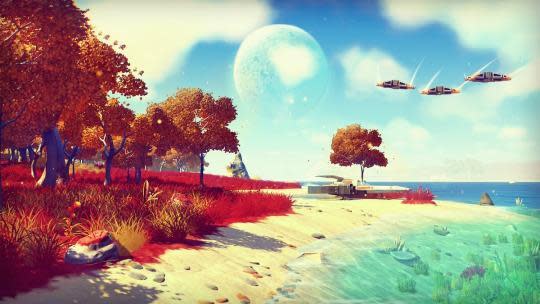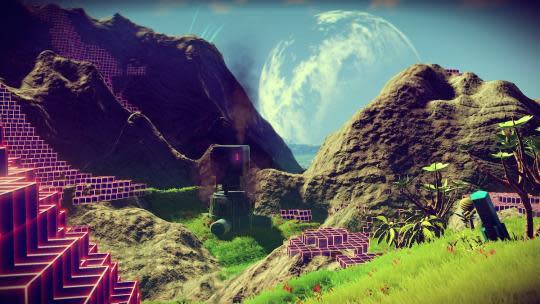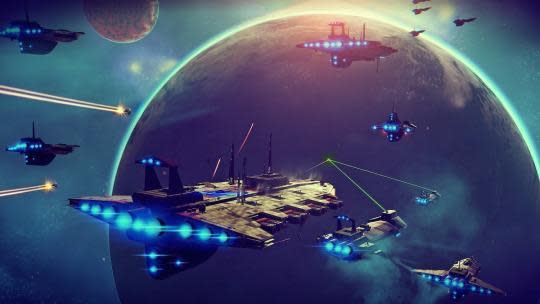I Played ‘No Man’s Sky’ for 10 Minutes, and It Was Awesome

(Image: Hello Games)
“So, what exactly do you do?”
That’s the question every single person asks me when I tell them I’ve played No Man’s Sky, the upcoming space adventure game from indie developer Hello Games.
It’s a perfectly fair thing to ask, because no one seems to know what exactly you’re supposed to do in No Man’s Sky. There is a vague, overarching goal. (Make your way to the center of the universe.) But in the year and a half since the game was first announced at the 2013 Spike VGX Awards, it’s been unclear what that really means.
That hasn’t stopped the game from capturing the imaginations of millions of gamers. It features a universe boasting over 18 quintillion planets. (Yes, that’s a real number.) Players fly spaceships, land them on mysterious worlds, get out, walk around, take pictures of creatures, and occasionally shoot things. The game’s technical chutzpah is so outlandish that it earned a spread in the New Yorker, of all places. It’s the most hyped video game in years, a fact that isn’t lost on Hello Games founder and somewhat reluctant No Man’s Sky spokesman Sean Murray.
“Hopefully people feel a real, justified sense of excitement rather than ‘hype,’ which to me says, ‘I know I’m going to feel let down,’” Murray told me at the recent E3 convention in Los Angeles. “It’s a level of excitement that’s impossible to reach.”

(Image: Hello Games)
He looked vaguely worried when he said this, and you couldn’t blame him. Having put the game front and center on stage at two consecutive E3 press conferences, Sony has made it clear that it’s a major priority for the PS4 (never mind that it’s also coming to the PC). It still has no formal release date, but with the surefire blockbuster Uncharted 4: A Thief’s End getting delayed into 2016, Sony would love to get No Man’s Sky on store shelves during this year’s holiday season. No Man’s Sky is riding shotgun on the video game hype train, putting a tremendous amount of pressure on its tiny, 10-person production team in Guildford, England.
With all the hype and expectation surrounding the game, I was actually a little nervous when Murray handed me the controller and let me fly around his complicated sandbox for 10 minutes. Was it going to be tons of fun, or was I getting a front row seat to an impending disaster?
Honestly, I’m still not entirely sure. But I feel much more confident that it’s capable of delivering on its grandiose promise.
I started off inside a small spacecraft and immediately headed over to a nearby planet to test out if, indeed, you can fly through the atmosphere and seamlessly land your ship on a planet. It took about a minute, but it worked. I got out of my ship and walked around on a lush, green field. I saw some water. I dove in and swam around. That also worked.
I found my way back to solid ground and tried my hand at gunplay by firing at a few large, chunky rocks. This is the No Man’s Sky version of mining, and sure enough, I accumulated a bunch of orange something or other, which was just enough to create a new weapon.
The bulk of No Man’s Sky is procedurally generated — that is to say it’s created by the game’s top-secret algorithmic code. Hello Games didn’t, after all, handcraft 18 quintillion planets; instead, the game generates those using some seriously awesome math and a wealth of variables. It doesn’t stop at planets, either: Pretty much everything is procedurally generated, from the creatures you encounter to the weapons you can build when you mine enough orange something or other.
The gun I crafted was unique: a weird, reddish laser pistol not entirely unlike the sort of thing Marvin the Martian might wave at Bugs Bunny. It boasted several expansion slots, each of which could be equipped with upgrades. It also boosted my mining capabilities, allowing me to mine some red something or other from a previously unminable rock.

(Image: Hello Games)
This is where another common question about No Man’s Sky popped into my head: “Is there money?” What better way to tie together the biggest universe ever created in a video game than with a living, breathing economy? Murray assured me that this is indeed the case.
“You can plot trade routes between systems, you can combine resources to create more valuable goods, and you can sell those for a profit,” he confirmed.
This is really important. The gameplay loop of mining, selling, buying, and upgrading gives No Man’s Sky — a game that ostensibly has no point — a point. Or more accurately, it provides a hook for those hoping for a more traditional video game experience, as in Privateer or Elite: Dangerous.

(Image: Hello Games)
“A thing that’s really popular for people to do — people who I’ve watched play No Man’s Sky — is being a trader,” Murray told me. “Not even crafting or mining. Just trading. People do that, and it blows my mind. There’s this whole universe we’ve created, and what they’re doing is the closest thing to a job. It says something about what makes people happy when they play games.”
Murray himself isn’t really in it for that, but his team has built leaderboards to track those who have acquired the most wealth, killed the most creatures, or discovered the most species. Incidentally, cataloging the world is another way to earn cash (called “units”), as every single item found is uploaded to a massive, shared, intergalactic atlas. Or you can be a dangerous space pirate, attacking other ships and space stations and using the resources to build more fearsome ships and guns. There is, most definitely, stuff to do in this video game.
But when describing No Man’s Sky, Murray seems to feel more comfortable likening it to Minecraft and Terraria, games that are less objective-based and more about creative expression and exploration. While No Man’s Sky won’t allow you to build giant structures (or, if you can, that capability hasn’t been revealed), it channels the same kind of energy as those sandbox games, just on a much bigger scale.
And by “much bigger,” I’m talking about orders of magnitude. Having mined and explored a bit of the first planet, I hopped back into my ship, flew out to space, pressed the PS4 touchpad, and found myself staring at an impossibly huge star field. At Murray’s behest, I zoomed out, watching hundreds of tiny specks of light — each a solar system filled with planets and moons — whiz by. It was astonishing. I randomly chose one and warped to it.

(Image: Hello Games)
A few seconds later, I was orbiting another planet, surrounded by a fleet of imposing cruisers. I could have engaged them in combat, but Murray smartly dissuaded me from doing so, as it would have raised what they’re currently calling the player’s Wanted meter. (Murray freely admits this is a term ripped off from Grand Theft Auto.) Wreaking havoc on a planet incurs the wrath of robotic Sentinels, and the more trouble you cause, the more trouble the authorities will cause you.
“If you were continually being obnoxious as a player, then they will continue to come after you,” Murray clarified. “You can also hide out or fly away and evade and try to leave that behind. But once you get to a high enough level, it stays with you.”

(Image: Hello Games)
I flew past the armada and landed on another planet, where I found, among other things, a cave filled with valuable green something or other, several treasure chests at the bottom of a fish-filled ocean, and a bright red creature that could best be described as a cross between a Hobbit and a Care Bear. I didn’t shoot it. My demo ended.
But my brain was just getting started. Trying to wrap your head around a game of this size and scope is problematic, because there’s really never been a game quite like No Man’s Sky before. Is it fun? For 10 minutes, absolutely. I had fun flying a spaceship, I had fun warping to an unexplored planet, I had fun mining for valuable resources and meeting a bizarre red teddy bear monster. Will that be fun for 10 minutes more? How about an hour, or 50 hours? I’m afraid we won’t know the answer to that question until Sony sees fit to open the skies.
When he isn’t lost in space, Ben is right here on Twitter.
